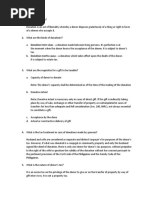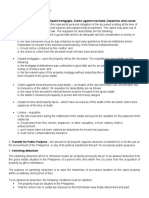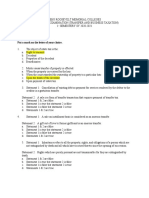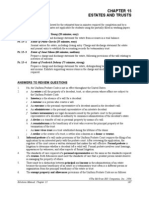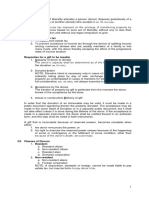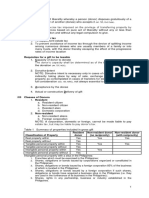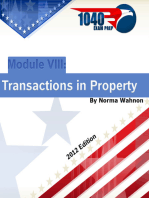Taxes: Transactions in Property
Uploaded by
El Sayed AbdelgawwadTaxes: Transactions in Property
Uploaded by
El Sayed AbdelgawwadMODULE 34 TAXES: TRANSACTIONS IN PROPERTY 499
However, for purposes of determining a loss, the basis of the property in the hands of the trans-
feree shall not be greater than the fair market value of the property at the time of the transfer.
EXAMPLE: Alan transfers property to his sister, Brianna, for $60,000. The property has a basis of $40,000 and a
FMV of $90, 000 at date of transfer. Alanmust recognize a gain of $60,000 - $40,000 = $20,000, and has made a .
gift to Brianna of $90, 000 - $60,000 = $30,000. Brianna's basis for the property is $60,000.
EXAMPLE: Brenda transfers property to her brother, Carl, for $30,000. The transferred property has a basis of
$40,000 and a FMV of $90,000 at date of transfer. Brenda's realized loss of $40,000 - $30,000 = $10,000 cannot
be recognized, and she has made a gift to Carl of $90,000 - $30,000 = $60,000. Carl's basis for the property is
$40,000.
EXAMPLE: David transfers property to his son, Evan, for $30,000. The property has a basis of $90,000 and a
FMV of $60,000 at date of transfer. David's realized loss of $90,000 - $30,000 = $60,000 cannot be recognized,
and he has made a gift to Evan of $60,000 - $30,000 = $30,000. Evan's basis for the property is $90,000. How-
ever, for purposes of determining a loss on a later sale or other disposition of the property by Evan, the property's
basis is limited to its FMV at date of transfer of $60, 000.
9. Transfer between spouses
a. No gain or loss is generally recognized on the transfer of property from an individual to (or in trust
for the benefit of)
(1) A spouse (other than a nonresident alien spouse), or
(2) A former spouse (other than a nonresident alien former spouse), if the transfer is related to the
cessation of marriage, or occurs within one year after marriage ceases
b. Transfer is treated as if it were a gift from one spouse to the other.
b. Transferee's basis in the property received will be the transferor's basis (even if FMV is less than
the property's basis).
EXAMPLE: H sells property with a basis of $6,000 to his spouse, W, for $8,000. No gain is' recognized to H, and
W's basis for the property is $6,000. W's holding period includes the period that H held the property.
d. If property is transferred to a trust for the benefit of a spouse or former spouse (incident to di-
vorce)
(1) Gain is recognized to the extent that the amount of liabilities assumed exceeds the total ad-
justed basis of property transferred.
(2) Gain or loss is recognized on the transfer of installment obligations.
10. Gain from the sale or exchange of property will be entirely ordinary gain (no capital gain) if the
prop-
erty is depreciable in hands of transferee and the sale or exchange is between
a. A person and a more than 50% owned corporation or partnership
a. A taxpayer and any trust in which such taxpayer or spouse is a beneficiary, unless such benefici-
ary's interest is a remote contingent interest "
b. Constructive ownership rules apply; use rules in Section 7.a.(4)(a) and (b) above
B. Capital Gains and Losses
1. Capital gains and losses result from the "sale or exchange of capital assets." The term capital
assets
includes investment property and property held for personal use. The term specifically excludes
a. Stock in trade, inventory, or goods held primarily for sale to customers in the normal course of
business
a. Depreciable or real property used in a trade or business
b. Copyrights or artistic, literary, etc., compositions created by the taxpayer
(1) They are capital assets only if purchased by the taxpayer.
(2) Patents are generally capital assets in the hands of the inventor.
d. Accounts or notes receivable arising from normal business activities
e. US government publications acquired other than by purchase at regular price
f. Supplies of a type regularly used or consumed by a taxpayer in the ordinary course of the tax-
payer's trade or business
2. Whether short-term or long-term depends upon the holding period
a. Long-term if held more than one year
a. The day property was acquired is excluded and the day it is disposed of is included.
You might also like
- ReSA B48 TAX First PB Exam Questions, Answers and SolutionsNo ratings yetReSA B48 TAX First PB Exam Questions, Answers and Solutions14 pages
- Unit-8 Innovation and Commercialisation TASK 1&2No ratings yetUnit-8 Innovation and Commercialisation TASK 1&229 pages
- A Manual of Hedging Commodity Price Risk For CorporatesNo ratings yetA Manual of Hedging Commodity Price Risk For Corporates23 pages
- PWC Adaptable Financial Institution Operating ModelNo ratings yetPWC Adaptable Financial Institution Operating Model40 pages
- Amin Akrami Student ID: 99162538: Operation Management Course Homework #4No ratings yetAmin Akrami Student ID: 99162538: Operation Management Course Homework #44 pages
- TA Xes: Transactions in Property: (5) The Basis of Like-Kind Property Received Is The Basis of Like-Kind Property GivenNo ratings yetTA Xes: Transactions in Property: (5) The Basis of Like-Kind Property Received Is The Basis of Like-Kind Property Given2 pages
- Nontaxable Exchanges Like-Kind Exchanges - 1031No ratings yetNontaxable Exchanges Like-Kind Exchanges - 10316 pages
- Chapter 15, Modern Advanced Accounting-Review Q & Exr100% (2)Chapter 15, Modern Advanced Accounting-Review Q & Exr16 pages
- Deductions: Philippines Gross Estate World Gross Estate Deductible LITNo ratings yetDeductions: Philippines Gross Estate World Gross Estate Deductible LIT3 pages
- TRAIN LAW - Estate TAxSUMMARY OF CHANGESNo ratings yetTRAIN LAW - Estate TAxSUMMARY OF CHANGES11 pages
- TRAIN LAW - Estate TAX - SUMMARY OF CHANGESNo ratings yetTRAIN LAW - Estate TAX - SUMMARY OF CHANGES10 pages
- Taxes: Transactions in Property: Involuntary ConversionsNo ratings yetTaxes: Transactions in Property: Involuntary Conversions1 page
- Donor's Tax A) Basic Principles, Concept and DefinitionNo ratings yetDonor's Tax A) Basic Principles, Concept and Definition4 pages
- 2024.02.02 HWF To OC Outlining Settlement Agreement W ChartNo ratings yet2024.02.02 HWF To OC Outlining Settlement Agreement W Chart23 pages
- Definitions - No Definition in The Code For: G. Capital Gains & LossesNo ratings yetDefinitions - No Definition in The Code For: G. Capital Gains & Losses5 pages
- Taxation Report - Valuation of Properties - Vanishing DeductionNo ratings yetTaxation Report - Valuation of Properties - Vanishing Deduction49 pages
- Taxes: Transactions in Property: B.1 Capital AssetsNo ratings yetTaxes: Transactions in Property: B.1 Capital Assets2 pages
- Principles of Taxation for Business and Investment Planning 2015 18th Edition Jones Solutions Manual download100% (2)Principles of Taxation for Business and Investment Planning 2015 18th Edition Jones Solutions Manual download45 pages
- CCH Federal Taxation Comprehensive Topics 2013 1st Edition Harmelink Test Bank100% (34)CCH Federal Taxation Comprehensive Topics 2013 1st Edition Harmelink Test Bank20 pages
- WME Exam Prep Questions: CSI/Foran WME Quiz Workbook and Case Study WorkbookNo ratings yetWME Exam Prep Questions: CSI/Foran WME Quiz Workbook and Case Study Workbook3 pages
- Get Federal Taxation Basic Principles 2013 1st Edition Harmelink Test Bank free all chapters100% (6)Get Federal Taxation Basic Principles 2013 1st Edition Harmelink Test Bank free all chapters55 pages
- 91-12 CPAR Donors Tax (Batch 91) - HandoutNo ratings yet91-12 CPAR Donors Tax (Batch 91) - Handout14 pages
- Federal Taxation Basic Principles 2013 1st Edition Harmelink Test Bank - Free Access To All Available Content For Download100% (3)Federal Taxation Basic Principles 2013 1st Edition Harmelink Test Bank - Free Access To All Available Content For Download61 pages
- Principles of Taxation for Business and Investment Planning 2019 22nd Edition Jones Solutions Manual download100% (2)Principles of Taxation for Business and Investment Planning 2019 22nd Edition Jones Solutions Manual download47 pages
- Module 22 Federal Securities Acts and Antitrust LawNo ratings yetModule 22 Federal Securities Acts and Antitrust Law2 pages
- C Ayton Act of 1914: Module 22 Fe E A SE UNo ratings yetC Ayton Act of 1914: Module 22 Fe E A SE U2 pages
- M Dule 22 Federal Securities Acts and Antitrust LawNo ratings yetM Dule 22 Federal Securities Acts and Antitrust Law2 pages
- Agency: I. Formation of The Agency RelationshipNo ratings yetAgency: I. Formation of The Agency Relationship7 pages
- Module 22 Federal Securities Acts and Antitrust LawNo ratings yetModule 22 Federal Securities Acts and Antitrust Law2 pages
- Federal Securities Acts and Antitrust LawNo ratings yetFederal Securities Acts and Antitrust Law3 pages
- P L N L U N N T MP: Sarbanes-Ox Eyactof2 2No ratings yetP L N L U N N T MP: Sarbanes-Ox Eyactof2 22 pages
- Federal Securities Acts and Antitrust Law: C o C eNo ratings yetFederal Securities Acts and Antitrust Law: C o C e2 pages
- Module 26 Secured Transactions:: o C, G eNo ratings yetModule 26 Secured Transactions:: o C, G e2 pages
- Module 26 Secured Transactions:: S G S C R eNo ratings yetModule 26 Secured Transactions:: S G S C R e2 pages
- Fi V Y, A (A A y I R S (B) A R S Si: Secured TransactionsNo ratings yetFi V Y, A (A A y I R S (B) A R S Si: Secured Transactions2 pages
- The - Use - of - Country - of - Origin - Information South AfricaNo ratings yetThe - Use - of - Country - of - Origin - Information South Africa55 pages
- Advances in Doctoral Research in Management by Luiz Moutinho, Graeme Hutcheson, Paulo Rita PDFNo ratings yetAdvances in Doctoral Research in Management by Luiz Moutinho, Graeme Hutcheson, Paulo Rita PDF293 pages
- Chapter 6: Conceptual Framework - Recognition and Measurement RecognitionNo ratings yetChapter 6: Conceptual Framework - Recognition and Measurement Recognition5 pages
- ab0QoobySU29EKKG8vlNug - ACCY 506 Module 1 TranscriptNo ratings yetab0QoobySU29EKKG8vlNug - ACCY 506 Module 1 Transcript39 pages
- Fin081 Liquidity Ratio Au Fa1 Bsa2 Main6No ratings yetFin081 Liquidity Ratio Au Fa1 Bsa2 Main611 pages
- Managerial Economics & Business Strategy: Managing in Competitive, Monopolistic, and Monopolistically Competitive MarketsNo ratings yetManagerial Economics & Business Strategy: Managing in Competitive, Monopolistic, and Monopolistically Competitive Markets46 pages



